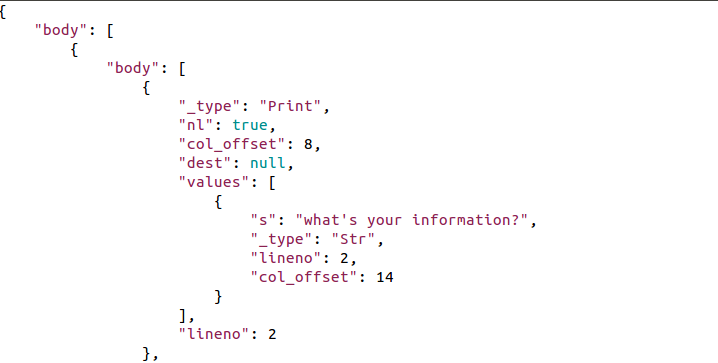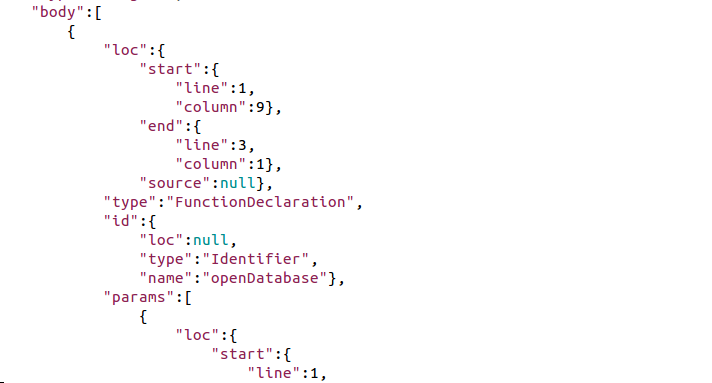
Difference: FRCVLabMLSA_description (2 vs. 3)
Revision 32017-04-07 - DamianLyons
| Line: 1 to 1 | ||||||||
|---|---|---|---|---|---|---|---|---|
How does it work? | ||||||||
| Changed: | ||||||||
| < < |  | |||||||
| > > |  | |||||||
| Changed: | ||||||||
| < < | The process starts with C and Python source code from which separate ASTs (Abstract Syntax Tree) are dumped using Clang-Check (for C files) | |||||||
| > > | The process starts with C, Python and JavaScript source code from which separate ASTs (Abstract Syntax Tree) are dumped using Clang-Check (for C files) | |||||||
| Changed: | ||||||||
| < < |  | |||||||
| > > |  | |||||||
| Figure 1: Portion of a C AST file | ||||||||
| Changed: | ||||||||
| < < | and the AST module (for Python files). | |||||||
| > > | the AST module and the file ast2json.py (for Python files), | |||||||
| Changed: | ||||||||
| < < |  | |||||||
| > > |  | |||||||
| Changed: | ||||||||
| < < | Figure 2: Portion of a Python AST file | |||||||
| > > | Figure 2: Portion of a Python AST json file | |||||||
| Changed: | ||||||||
| < < | The AST files have very different structures for C and Python, but the parsers are designed to handle each kind of AST differently. Those parsers filter the AST files detecting and recording function calls and their arguments. Initially, the program is capable of detecting literals and variables as arguments. Reaching Definition Analysis will be developed in the future in order to handle statically assigned variables as arguments to functions. The current version of the program handles part of the Python.h interface between C and Python. It only analyzes “PyRun_SimpleFile” calls. Other mechanisms for calling Python from C will also be implemented in the future. | |||||||
| > > | And SpiderMonkey for JavaScript files. | |||||||
| Changed: | ||||||||
| < < | When a call to “PyRun_SimpleFile” is found, its argument (name of the python file) is considered a function call and the executable portion of that python file is represented as the main function in C. That creates the connection between the C and the Python files, which allows the subsequent programs to build the call graph. | |||||||
| > > |  | |||||||
| Changed: | ||||||||
| < < | “CombineCSV.py” combines all individual csv files from the list of source files into one. This file is then used as input to “GenerateDot.py”. This program translates the csv file to a dot file, which represents the csv file as a graph. The Dot program builds the final graph and saves it as a PDF file. Circular nodes represent C functions and Rectangular nodes represent Python functions. | |||||||
| > > | Figure 3: Portion of a JavaScript AST json file | |||||||
| Added: | ||||||||
| > > | The AST files have very different structures for C and Python, but the parsers are designed to handle each kind of AST differently. Those parsers filter the AST files detecting and recording function calls and their arguments. Initially, the program is capable of detecting literals and variables as arguments. Reaching Definition Analysis will be developed in the future in order to handle statically assigned variables as arguments to functions. The current version of the program handles part of the Python.h interface between C and Python. It only analyzes “PyRun_SimpleFile” calls. Other mechanisms for calling Python from C will also be implemented in the future. | |||||||
| Changed: | ||||||||
| < < |  | |||||||
| > > | When a call to “PyRun_SimpleFile” is found, its argument (name of the python file) is considered a function call and the executable portion of that python file is represented as the main function in C. That creates the connection between the C and the Python files, which allows the subsequent programs to build the call graph. | |||||||
| Added: | ||||||||
| > > | “CombineCSV.py” combines all individual csv files from the list of source files into one. This file is then used as input to “GenerateDot.py”. This program translates the csv file to a dot file, which represents the csv file as a graph. The Dot program builds the final graph and saves it as a PDF file. Circular nodes represent C functions and Rectangular nodes represent Python functions. | |||||||
| Changed: | ||||||||
| < < | Figure 3: Example of a multilingual call graph | |||||||
| > > |  | |||||||
| Added: | ||||||||
| > > | Figure 4: Example of a multilingual call graph | |||||||
Permissions | ||||||||
| Line: 43 to 45 | ||||||||
| ||||||||
| Added: | ||||||||
| > > |
| |||||||
View topic | History: r9 < r8 < r7 < r6 | More topic actions...
Ideas, requests, problems regarding TWiki? Send feedback